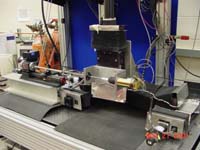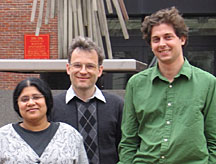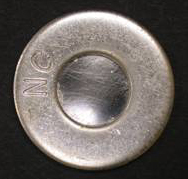Research
Highlights...
|
 |
Number 182 |
April 25, 2005 |
|
An exceptionally effective lead-detection protein
Scientists from DOE's Brookhaven National Laboratory and the University of Chicago have discovered that a member of a well-known protein family is better at detecting lead than any other known substance. In fact, the protein is more than one thousand times more likely to bind to lead than other metals, such as mercury, zinc, or copper. Learning more about the protein's structure and lead-detection mechanism may lead to new ways to synthesize drugs or to develop treatments for lead poisoning, a worldwide problem that, in the U.S. alone, inflicts irreversible physical damage to half a million children each year.
[Laura Mgrdichian, 631/344-8191,
mgrdichian@bnl.gov]
|
|
Newly patented system fights corrosion
|
PNNL's fully automated electrospark deposition technology fights corrosion and wear and tear in even the hardest-to-reach places. |
Researchers at DOE's Pacific Northwest National Laboratory have made a key advance in developing a fully automated system that fights corrosion and wear and tear in even the hardest-to-reach places. The Electrospark Deposition, or ESD, system is a fully automated apparatus that transfers a very low heat, controlled weld of a metallic coating onto surfaces that may become corroded. A computer monitors the spark current, which indicates the contact force, and adjusts the equipment to maintain the optimum contact force. Users of the system can align the part, start the computer, and return when the application is completed. It can be particularly useful in industries where large quantities of repairs are needed, such as aviation and aerospace, military hardware, medical, timber, automotive and food processing. PNNL recently licensed the ESD automation technology to Advanced Surfaces and Process Inc. of Cornelius, Oregon.
[Andrea Turner, 509/375-3893,
andrea.turner@pnl.gov]
|
|
DZero sets new top for top quark measurement
|
The analyses were carried out by a team from Boston University:
graduate students Kevin Black (right), Sarosh Fatakia (not pictured),
postdoc Lars Sonnenschein (not pictured) and Professors Meenakshi
Narain (left), Ulrich Heintz (center). |
The DZero collider experiment at the Department of Energy's Fermilab has completed two preliminary measurements of the top quark mass using data from Run II of the Tevatron. The result—170.6 +/- 7.3 GeV/c2—is the most precise measurement of the top quark mass from Run II data to date. The Tevatron, where the top quark was discovered in 1995 by the DZero and CDF experiments, is still the only source of top quarks. Measuring the properties of the top quark in detail makes it possible to test theoretical predictions, such as the connections between the top, the W boson and predictions for the mass of a Higgs boson. [Mike Perricone, 630/840-5678,
mikep@fnal.gov]
|
|
Chemical guidebook may help Mars rover track extraterrestrial life
To help a NASA rover eventually hunt for life on Mars, Idaho National Laboratory scientists are writing a chemical guidebook to aid the search for extraterrestrial life. Using new imaging tools and earthly parallels of ancient Mars environments, they're recording the types of subtle chemical changes that Martian microbes may have left on the planet's rocks. The researchers hope someday to arm a Mars rover with a suite of tools – a guidebook, precise chemical imagers, and human-like reasoning ability – and let it search for signs of alien life on its own.
[Reuel Smith, 208/526-3733,
mrs@inel.gov]
|
|
'Chemical dynamic' duo aids Navy
Researchers at DOE's Pacific Northwest National Laboratory and the University of Minnesota are developing new computational capabilities for the Navy that ultimately will lead to more efficient electric power for ships and tougher, lighter-weight materials. The work will also help the Navy use energy resources more efficiently. The research specifically seeks to better understand and predict the motion of molecules, or chemical dynamics. This fundamental understanding is the basis for technology innovations that will create, manage and control energy in the Navy's all-electric ship, and control the design of new materials for future naval systems. The partners will take advantage of advances in molecular theories, computer algorithms, and computer power to develop software. The software will provide simulations and accurate calculations of chemical properties that can be applied to complex chemical systems to understand how the motions and reactions of molecules can be manipulated to control complex chemical processes.
[Andrea Turner, 509/375-3893,
andrea.turner@pnl.gov]
|
|
|
LLNL's Dona Crawford sets BlueGene's pace

|
|
LLNL's Dona Crawford
|
Dona Crawford, the Associate Director of Lawrence Livermore National Laboratory's Computation Directorate, is responsible for the development and deployment of integrated computing and information environments capable of terascale simulations.
“These machines are the backbone of science and technology,” Crawford said. “The simulations performed on these machines will enable virtually every scientific field for decades to come.”
Crawford, was recently named to the Alameda County Women's Hall of Fame in the Science category for her work and her leadership in establishing the world fastest supercomputer, called Blue Gene/L, at Lawrence Livermore.
“I am honored to accept this award on behalf of the large team of scientists and engineers at the Lab, at IBM (BlueGene/L's developer) and at DOE/NNSA who made it possible,” Crawford said. “It's even more rewarding because of its significance and importance to the Laboratory and its missions.”
Last November, Blue Gene/L took center stage in the technological world when the supercomputing industry proclaimed the computer the world's fastest computer on the Top500 list . At 70.72 teraflops, or trillion operations per second, Blue Gene/L outpaced the previous top performer, Japan 's Earth Simulator, which had held the top spot for three years. Blue Gene/L was just one quarter of its eventual capability; since that time the second quarter of the machine has been installed and has achieved 135.3 teraflops .
Blue/Gene L will be used to ensure the safety and security of the nuclear stockpile and set the stage for myriad breakthroughs in chemistry, physics, engineering, medicine and materials science.
She also promotes math and science careers for young women in the Tri-Valley area through her participation in community outreach activities such as the Expanding Your Horizons conferences held three times each year, the Go Figure Math Competition and numerous high school achievement awards.
Submitted by DOE's
Lawrence Livermore
National Laboratory
|
|




